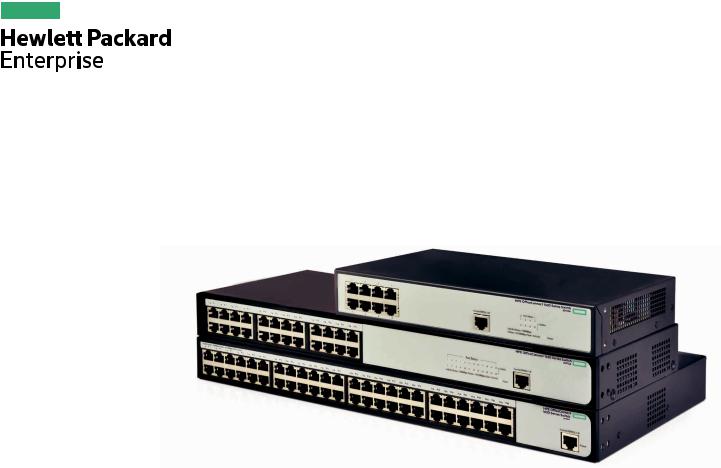HP 1620 24G User Manual

Data sheet
HPE OfficeConnect 1620
Switch Series
Key features
•Entry-level, smart-managed Layer 2 switches
•8-, 24-, and 48-port gigabit models are rack-mount capable with included hardware
•8- and 24-port models run quiet (fanless)
•All models include internal power supplies
•Limited Lifetime Warranty
Product overview
HPE OfficeConnect 1620 Switch Series are entry configurable switches for small business networking, a step up from unmanaged devices, with features to enhance network security, performance and reliability. The series is part of the OfficeConnect portfolio of Hewlett Packard Enterprise small business networking products.
These Gigabit switches are plug-and-play out of the box, yet network operations can be fine-tuned through features available from a simple Web browser-based GUI, if necessary. Enhance security using virtual LANs, link aggregation, or IGMP Snooping boost uplink performance, and loop prevention enhances network reliability.
The series consists of 8-, 24-, and 48-port 10/100/1000BASE-T models each providing nonblocking gigabit per port performance. All models can be rack mounted and include the necessary rack-mounting hardware; the 8-port model can also be wall mounted. All models come with internal power supplies and localized power cord removing the need to manage external power adapters. The 8- and 24-port models are fanless for silent operation.
This series comes with a Limited Lifetime Warranty providing advance hardware replacement with next business day shipment in most countries, 24x7 phone support available for the first 90 days, and electronic and business hours phone support for the entire warranty period.
Data sheet |
Page 2 |
Features and benefits
Management
•Simple Web management
Allows for easy management of the switch even by nontechnical users through an intuitive Web GUI; supports HTTP and HTTP Secure (HTTPS)
•Secure Web GUI
Provides a secure, easy-to-use graphical interface for configuring the switch via HTTPS
•SNMPv1, v2c, and v3
Facilitates management of the switch, as the device can be discovered and monitored from an SNMP management station
•Port mirroring
Enables traffic on a port to be simultaneously sent to a network analyzer for monitoring
•Default DHCP Client mode
Allows the switch to be directly connected to a network, enabling plug-and-play operation; in absence of a DHCP server on the network, the switch will fall back to a unique static address determined by the switch’s MAC address
•Network Time Protocol (NTP)
Synchronizes timekeeping among distributed time servers and clients; keeps timekeeping consistent among all clock-dependent devices within the network so that the devices can provide diverse applications based on the consistent time
•Manual network time configuration
Manually set the date and time on the switch in the absence of a NTP server
•Dual flash images
Provide independent primary and secondary operating system files for backup while upgrading
Quality of service (QoS)
•IEEE 802.1p prioritization with DSCP
Delivers data from the switch to devices based on the priority and type of traffic using Differentiated Services Code Point (DSCP)
•Broadcast control
Allows limitation of broadcast traffic rate to cut down on unwanted network broadcast traffic
•Rate limiting
Sets per-port ingress enforced maximums and per-port, per-queue minimums
Data sheet |
Page 3 |
Connectivity
•Auto-MDI/MDIX
Automatically adjusts for straight-through or crossover cables on all ports
•IEEE 802.3X Flow Control
Provides a flow throttling mechanism propagated through the network to prevent packet loss at a congested node
•Loopback detection
If the switch detects a loop, it disables the source port from forwarding data packets originating from the switch to avoid broadcast storms
•Energy Efficient Ethernet
Compliant with IEEE 802.3az standard requirements to save energy during periods of low data activity
•Port power save mode
Enables a port to operate at the lowest transmission speed or go down during a specific time range on certain days of a week. The port resumes when the effective time period ends
•Cable test
Performs a check on the status of the cable connected to an Ethernet port on the device. The test determines whether a short circuit or open circuit is present on the cable and the approximate length to the fault in the cable
Performance
•Halfand full-duplex auto-negotiating capability on every port doubles the throughput of every port
•IGMP Snooping, v1, v2, and v3
Improves network performance through multicast filtering, instead of flooding traffic to all ports
Layer 2 switching
•VLAN support and tagging
Supports IEEE 802.1Q with 4,096 simultaneous VLAN IDs
•Jumbo frame support
Supports up to 10 kilobyte frame size to improve the performance of large data transfers
